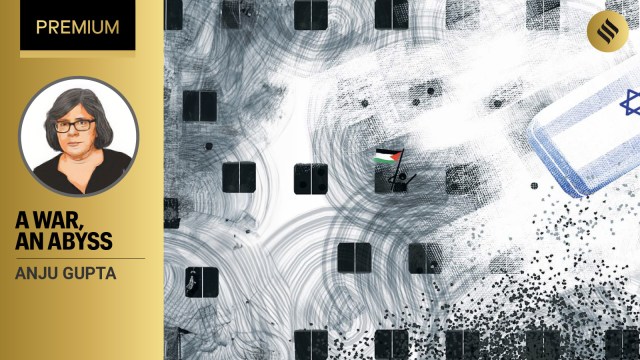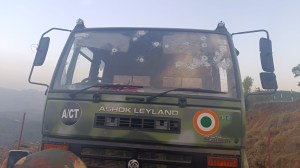- India
- International
Four ways the Israel-Hamas-Iran conflict has led to a more volatile Middle East
The administration of 2.3 million Palestinians now totally hostile to Israel and rebuilding of almost-completely devastated Gaza, peppered with unexploded munitions and mines, are challenges that will consume Israel and allies for years
 Palestinian children sit next to the site of an Israeli strike on a house, amid the ongoing conflict between Israel and the Palestinian Islamist group Hamas, in Rafah, in the southern Gaza Strip. (Reuters)
Palestinian children sit next to the site of an Israeli strike on a house, amid the ongoing conflict between Israel and the Palestinian Islamist group Hamas, in Rafah, in the southern Gaza Strip. (Reuters)Six months after the October 7 attack, Israel’s war to eliminate Hamas has resulted in the near-complete destruction of Gaza and a dire humanitarian crisis with the area on the verge of famine. Iran and its allies have militarily united behind the Palestinian cause and expanded the confrontation to other parts of the region.
However, the dynamics of war have drastically changed following the massive Iranian drone and missile attacks on military targets in Israel on April 14. This was in retaliation to Israeli aerial strikes on an Iranian diplomatic compound in Damascus on April 1 in which top Iranian generals were killed. Israel had not seen direct attacks by a state on its soil since 1991 when Saddam Hussein fired 42 Scud missiles.
Israel’s ‘symbolic message’ to Iran
On April 19, some Western and pro-Israel media claimed that Israel struck Iranian nuclear facilities in Isfahan. Dismissing the claim, Iran asserted that its air defence system had been activated across cities in response to the presence of “three mini drones” over Isfahan, which were shot down. Officially, Israel has not claimed the attack, while the US Secretary of State referred to them as “reported events”.
However, the propaganda around this “symbolic message” to Iran, seems to suggest that for now, the escalating situation has been “controlled” more with a “media war of narrative” to avoid further escalation by both sides. The US seems to have played a key role in defusing the situation by announcing early on that, though it stood committed to Israel’s defence, it would not take part in any offensive against Iran.
At this juncture, what remains to be seen, is how soon talks between Hamas and Israel, nudged by the US and mediated by Qatar and Egypt can be revived to negotiate a prolonged ceasefire, more humanitarian assistance to Gaza and the release of the remaining Israeli hostages. The international community appears united on these issues, but the latest round of the Israel-Iran confrontation is likely to obstruct these efforts.
A more volatile Middle East

The geopolitics of the region has already undergone a sea change since October 7 in four substantive ways.
First, thawing of the hitherto icy Shia-Sunni relationship, with Hezbollah, Houthis and Iran (all Shia entities) extending open support to “Sunni” Palestinians, presenting regional unity via the Axis of Resistance, opposing US-Israel domination. The first signs of the Resistance surfaced early on in the war, with conflict with Hezbollah in northern Israel leading to the displacement of thousands of Israeli civilians who are yet to return. This active front is likely to simmer.
Second, the war has expanded across the region, pushing the US to become the fulcrum of efforts to contain expansion and making it a primary target. Various affiliates of the Axis have mounted hundreds of rocket and drone attacks on US bases across Syria, Iraq and Jordan since October 7, with US forces targeting sources of such attacks across Iraq and Syria. However, in early February, Iran finally restrained the majority of the Axis militia from attacking US targets, which resulted in the latter curtailing retaliatory aerial strikes. Over these six months, the US and Iran have calibrated their actions and successfully avoided direct military confrontation. However, the situation remains fragile due to multiple non-state and state actors all of whom cannot always be restrained by either Iran or the US. The Israeli strike in Damascus on April 1 and reports of “still unverified” aerial attacks on US bases in Syria on April 22 are such examples.
Third, the Saudi-aligned Sunni Arab States have adopted the political and diplomatic route, advocating a ceasefire, supporting humanitarian assistance, and calling for a two-state solution while remaining in line with US-led initiatives. Quite early on, Saudi Arabia announced a cessation of normalisation of ties with Israel but it took four months for it to categorically state that there would be no diplomatic relations with Israel unless an independent Palestinian state is recognised with borders as in 1967 and with East Jerusalem as its capital.
Fourth, the Yemen-based Houthis — a non-state actor devoid of a navy — have managed to successfully disrupt a critical sea lane of communication for five months, impairing trade substantively. It has done so using drones, missiles and unmanned attack drone boats. Coupled with drought conditions in the Panama Canal and the resultant drop in traffic, highly time-sensitive global supply chains have had to make expensive adjustments to routes and schedules, with insurers upping premiums to levels approaching, but not close to, those in the Black Sea.
The cost of war
The expansion of the war has already caused economic distress to the Israeli economy beyond direct costs, which, as early as October last year, were estimated to be over a quarter of a billion dollars a day. The Israeli economy has reportedly shrunk by 20 per cent in the last quarter of 2023. Two crucial Israeli ports, Eilat on the Red Sea and Haifa on the eastern Mediterranean have been sporadically attacked. The Eilat port is said to be down to a quarter of its business, while Israeli media reports an acute shortage of labour in Israel, primarily on account of military conscription and volunteerism. Following the Israel-Iran confrontation, on April 19, S&P lowered Israel’s long-term rating by a notch.
Israel has consistently asserted that it won’t stop its attacks until all three goals — elimination of Hamas, release of all hostages and removal of the threat from Gaza — are achieved. Israel has claimed that 75 per cent of Hamas is destroyed, while only about half the hostages have been released in negotiations brokered by Qatar. The US has categorically stated that means other than ground operations should be used for flushing out Hamas from Rafah, which appears unacceptable to Israel.
Whether Israel’s war on Gaza ends soon or not, the administration of 2.3 million Palestinians now totally hostile to Israel and rebuilding of almost-completely devastated Gaza, peppered with unexploded munitions and mines, are challenges that will consume Israel and allies for years, should Israel occupy Gaza or not. The Israel-Iran conflict is going to loom large not just over the resolution of Gaza, but peace and stability across the Middle East for decades to come.
The writer is a security analyst and former Director General of Police
EXPRESS OPINION
More Explained
May 04: Latest News
- 01
- 02
- 03
- 04
- 05








































